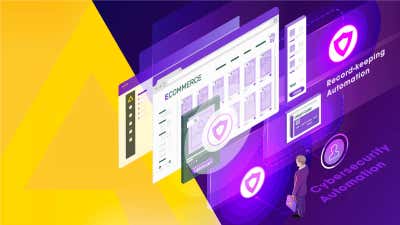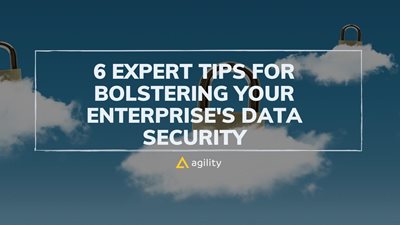4 Ways to Integrate Cybersecurity Automation In Your Enterprise
Cybersecurity Automation In Your Enterprise


As ecommerce increasingly becomes the main way businesses are interacting with customers, cybersecurity is becoming ever-more important.
Ecommerce is essential for modern businesses - allowing them access to global markets, to operate 24/7, and reducing travel for customers.
One of the key features of successful ecommerce businesses is automation. Automation can be used in everything from artificial intelligence and remote workforce management to customer service to supply chains, warehouse stock counts to shipping processes… and yes, cybersecurity.
Most businesses share the common goal of increasing efficiency and flexibility within their workforce. This is because increased efficiency & flexibility means more profit. Automation is a key part of increasing efficiency.
What Is Cybersecurity?
In basic terms, cybersecurity refers to the protection of anything to do with your computer systems, your data, your customers’ data, and the services those systems provide for your business. There are two main parts to cybersecurity: responding to current threats to your business and data and preventing future attacks.
Ideally, you want your business to prevent cybersecurity breaches before they happen. This involves tracking data surrounding attacks and successful responses in order to predict effective strategies against threats. Businesses should also be aware of constantly evolving threats and innovations such as deepfake technology and other ways data can be stolen and manipulated.
As companies move towards increasingly online business plans, cybersecurity is becoming progressively more important. Back in the day, when companies kept all of their information in filing cabinets in a back office, a thief would not only have had to be in the same geographical location as the data but would also have needed a physical opportunity to access the files.
This is no longer the case. One small breach in cybersecurity could expose your company’s information to millions of people and in any country or timezone. Not only that - a breach in cybersecurity could release your information to multiple parties simultaneously.
This is not to say that ecommerce is not the way forward for businesses. But as companies increasingly exist online rather than in physical locations, cybersecurity becomes that much more important.
Benefits of Automating Cybersecurity
Cyber threats are growing - so it’s important to have an up-to-date cybersecurity system. The aim is to reduce the number of attacks by reducing the number of weak points in your system. Cyber threats are also becoming more and more automated, so part of effectively combating them is having the right tools for the job - this means automated cybersecurity systems.
Cybersecurity tasks used to be performed by security staff, but automating those tasks offers greater accuracy and frees up staff for more complex work. With online threats appearing more frequently - and hackers using automated methods themselves - it is impossible for businesses to employ enough cybersecurity experts to manually counter those threats.
As enterprises improve the complexity of their network infrastructures, the complexity of the weak points in the system also increases. With further complexity comes increased vulnerability.
At the same time, businesses are dealing with greater amounts of data than ever before: there simply aren’t enough cybersecurity experts to manually analyze that data to a high standard. Automation allows the cybersecurity experts to give their full attention to the really dangerous threats and allow the system to deal with the rest.
Modern enterprises are increasingly finding that automation is beneficial to many aspects of their business. RPA (robotic process automation) allows businesses to increase productivity, automate warehousing and shipping, and improve their customer service stack via interactive voice recognition technology.
Cybersecurity is not excluded from these benefits: automation is faster at preventing threats than manual labor, as well as less prone to error and smoother at streamlining data from multiple sources.
When threats to your enterprise occur, automated cybersecurity systems quickly analyze data and predict the next point of attack. Automated systems can analyze a threat faster than human staff, which allows them to get ahead of the threat and prevent it from causing further damage to your business.
Let’s take a look at the four most successful methods that you could be integrating to ensure automated cybersecurity for your enterprise.
1. Cybersecurity Automation and a Business Process Management Plan
Business Process Management (BPM) is the process of making your business as efficient as possible. This means optimizing the processes you use, automating those that can be automated, and focusing staff resources on processes that can’t be automated. Your cybersecurity processes should be one of the most important parts of your BPM plan. A good BPM plan can help you find which methods of integrating cybersecurity are the best fit for your enterprise.
For example, a BPM plan can help you choose whether a “Security Orchestration Automation and Response” (SOAR) approach to cybersecurity is the best fit for your business, or whether you would be better off using “Security Incident and Event Management” (SIEM). Both methods use automated systems to collect and analyze data, but SIEM relies more on manual labor whereas SOAR uses artificial intelligence and machine learning to respond to threats automatically. Depending on your business, you might find one more efficient than the other.
BPM works by redesigning business processes in a way that means they can then be automated. This reduces human error and also frees up staff to spend time on human-contact heavy tasks. As part of the process, good BPM can automate and sync your cybersecurity systems so that there are no weak points.
For ecommerce businesses just starting out, a BPM plan can create systems that are easy to use with just a few staff, but which also allows space for you to scale up.
This means that you can be sure your data is protected to a high standard even if your staff is still learning. Integrating cybersecurity automation into your BPM from the start means that the security system will be cohesive, and any new expansions to your business can be smoothly integrated without the risk of being left with stitched-together security.
Fortunately, it’s still cost-effective for established businesses who also utilize VoiP services to integrate automated cybersecurity into their systems. A good BPM optimizes the systems you already have in place and means that once you switch to automated cybersecurity it will take fewer staff and resources to maintain.
As part of your BPM, it’s worth considering cloud native automation, which could include RPA. Cloud RPA is more secure than the in-house equivalent because it is constantly monitored. It also means that data is not stored on personal devices, which reduces the security risk if one of your company’s devices is lost or stolen.
Cloud-native automation is also financially beneficial: part of your company’s RPA journey will include reducing the infrastructure and maintenance costs of your cybersecurity system while also increasing its effectiveness.
2. Use Business Process Discovery to Analyze Your Systems
There might be places in your cybersecurity processes where you really do need a team member to look over the data. However, as we’ve already seen there are many parts of the cybersecurity system that can be automated. The important part is distinguishing which points need human contact and which don’t.
This is where business process discovery can be useful for integrating cybersecurity automation into your enterprise.
For example, there might be points in your hiring process that could benefit from recruitment automation. By analyzing your hiring process using business process discovery you might find that your staff spends a lot of time on skills testing and answering simple questions - both tasks which could be delegated to bots. Cybersecurity automation can help with reference and background checks, collecting data, and collating that data to help find the perfect candidate.
By using business process discovery techniques, you can find the points in your systems that can be automated. The process looks closely at the individual steps of each operation, and then automatically streamlines that operation in order to operate at maximum efficiency.
This means that not only is your cybersecurity using automation for the best possible protection, but the business process discovery will also help you remove any steps in the process that are unnecessary. Unnecessary steps mean more opportunities for data to be compromised, so a streamlined cybersecurity system is much safer than the clunky processes used by humans.
3. Consider Partner Relationship Management Software
Increasingly, ecommerce businesses are working on a “partner program” method of conducting business. This is when multiple companies team up to provide streamlined services between distributors, marketers, sales services, and outbound contact center services. Partner relationships should be mutually beneficial, but they still require businesses to spend time onboarding new partners, providing partner orientation, and scaling marketing tactics to suit new channels.
Partner relationship management software can help securely manage your relationships with other ecommerce enterprises. When companies are trying to give partners all the information they need to become effective allies, it is easy for cracks to appear in your cybersecurity.
PRM software can streamline the partnership so that information is not left unsecured. With multiple partners all collecting their own data it is easy for weak points to creep into your cybersecurity. A well-automated PRM system that collates data to a central hub is essential for the easy integration of cybersecurity automation into your company.
As well as streamlining the integration of cybersecurity automation into your business, a good PRM can also help with content management workflow, as it ensures exactly the right people get precisely the correct information.
Creating a central content hub can improve cybersecurity because the central hub manages the connections to each individual partner, and ensures that none of the individual systems can compromise another.
If one of your systems (or partner company’s systems) suffers a breach in security, a central hub is designed to not only cut off the compromised party but also keep the other aspects of the system running smoothly. This improves both cybersecurity and productivity.
4. Automate Your Record-keeping
Part of automating your cybersecurity should be automating the storage and access for various information related to your company. As part of your partner relationship management plan, you should also consider what information is necessary for your partners to be able to access, which people from each company can access it, and how they can access that info.
As part of your PRM, it’s important to allocate resources to cataloging and storing your company’s SSL and UCC certificates. You should be able to quickly access your company’s records showing which certificates you have, who issued them, and who has access to them. An Electronic Data Interchange (EDI) can help you out in the long run but you still need to take extra measures in terms of cybersecurity and an EDI can only do so much.
Although accurate knowledge of these certificates is essential for cybersecurity, keeping track of them is a fairly menial task and most companies are not big enough to make it worth hiring someone specifically for the job. This is where automated cybersecurity systems come in handy.
A well-automated cybersecurity system will automate the process of filing and keeping certificates, can classify them by type, issuer, and expiration dates, and provide search functions that allow you to easily and quickly bring up the relevant certification.
Automated cybersecurity systems can also offer notifications for certificate expirations, as well as automated renewal and installation processes, automated report generation, and automatic creation of end-users when they self-enroll.
Automating your cybersecurity to compile all your certificates is efficient, and will continue to improve efficiency for your workforce in the future. Similarly, it is worth considering gathering all of your domains to a system that manages them under one account.
Companies with a .io domain offer simple and easy-to-use accounts that keep track of all your domains and automatically manage them without being tied to a country-specific ccTLD such as .com, .co.uk, or .ca.
Cybersecurity Automation: Efficient and Successful
In the fast-moving world of ecommerce, the methods for successfully integrating cybersecurity automation into your company’s systems will be likely to grow and evolve with the emergence of new technology. However, the fact remains that automated cybersecurity is the only practical way of efficiently protecting your business and your data.
Your approach to cybersecurity automation should be built-in to your Business Process Management plan: a good BPM can help you decide which cybersecurity systems will be most effective for your business, and automated cybersecurity will help streamline other aspects of your infrastructure.
When integrating cybersecurity automation into your business, it is helpful to use Business Process Discovery to analyze parts of your system that might be specific to your particular brand. In some cases, there might be parts of the cybersecurity process where it is necessary to have an IT crew handling manual work, and it is important to recognize these pinch points.
Conversely, there may be times when automating your cybersecurity protects not only your business but the companies you work alongside. Integrating cybersecurity automation into your record-keeping and Partner Relationship Management Software can streamline your partnerships so that you can share information without compromising security.

About the Author
Richard Conn is the Senior Director for Demand Generation at 8x8, a leading communication platform with integrated contact center, voice, video, chat functionality, and analog PBX system for small business. Richard is an analytical & results-driven digital marketing leader with a track record of achieving major ROI improvements in fast-paced, competitive B2B environments. Check out his LinkedIn.


